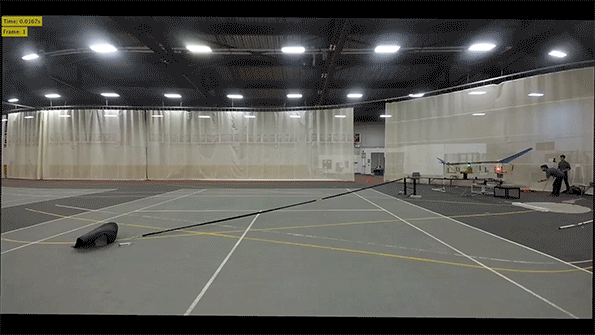A new type of plane created by engineers at MIT has no moving parts — no propellers or turbines in sight.

The plane instead only has some wires along the wings, and they create an ionic wind that propels the plane forward using only electricity.
That means it doesn’t burn up any fossil fuels — a first for any large-scale aircraft.
“This is the first-ever sustained flight of a plane with no moving parts in the propulsion system,” said Steven Barrett, associate professor of aeronautics and astronautics at MIT, in a statement.
“This has potentially opened new and unexplored possibilities for aircraft which are quieter, mechanically simpler, and do not emit combustion emissions.”
The results of the plane’s flight were published in the journal Nature.
RELATED: Solar Impulse 2 marks first round-the-world flight (2016)

So what is ionic wind?
The plane looks like a glider, with a series of thin wires, each of which has a corresponding aerofoil.
The wire has a substantially large positive charge of about 20,000 volts. The aerofoil is negatively charged correspondingly (meaning at -20,000 volts.)
They’re placed a little ways apart. The positive wire will attract the negative electrons — creating positive ions in the air.
Those charged air molecules will then be attracted to — and move towards — the negative aerofoil. They also push other air particles in the same direction, creating a wind.

Get breaking National news
“Using that mechanism, you create a large stream of air, and that has the advantage of rather than having a propeller or jet engine, which can be quite noisy. … It’s a quiet way, and efficient way, of creating a propulsive force,” Barret told Global News.

Previously, scientists have only been able to use ionic wind to make very small objects fly, but Barrett’s plane has a wingspan of five metres and weighs five pounds.
It’s still not enough, say, to lift a person into the air, but it is a step in the right direction.
“This was the simplest possible plane we could design that could prove the concept that an ion plane could fly,” Barret said in a statement. “It’s still some way away from an aircraft that could perform a useful mission. It needs to be more efficient, fly for longer, and fly outside.”
David Zingg, director of the University of Toronto’s Centre for Research in Sustainable Aviation, agreed.
A project like Barret’s “will be many decades before an idea like this could become practical for large commercial aircraft, if it can be made to work at all.”
But while it’s still early in development, aerospace engineering professor Guy Gratton told the Guardian it’s an exciting development.
“The team at MIT have done something we never previously knew was possible in using accelerated ionized gas to propel an aircraft,” he said.
“This technology will offer something else that in the future may allow manned and unmanned aircraft to be more efficient, and non-polluting.”
Barret told Global News he can see his technology going two ways, the first being used in drone technology. Further in the future, he can see it being used in commercial airplanes, maybe by combining the mechanism with current engines to create “more fuel-efficient, hybrid passenger planes and other large aircraft.”

Sustainable aviation for the future
Jet-setting to a far-off destination is cheaper than it’s ever been, but it comes at a cost — maybe not to your pocketbook, but to the environment.
A flight from Halifax to Vancouver emits 1.5 tonnes of carbon dioxide — that’s about 10 per cent of the yearly emission of an average Canadian, climate policy expert Tom Green explained. Globally, aviation amounts to about 2.5 per cent of all carbon emissions.
But the amount we fly is going up — meaning there will be more carbon emissions from air travel than ever before.
That’s why we need sustainable aviation, Zingg told Global News. He and his team are “are developing and investigating unconventional aircraft configurations” that can improve fuel efficiency.
“It’s very important to do this type of research so it’s promising to see this kind of research out of MIT,” Green said.
“This is the kind of thing that can happen when you’ve got good climate policy … that gives inventors the incentive to develop these types of products.”








Comments